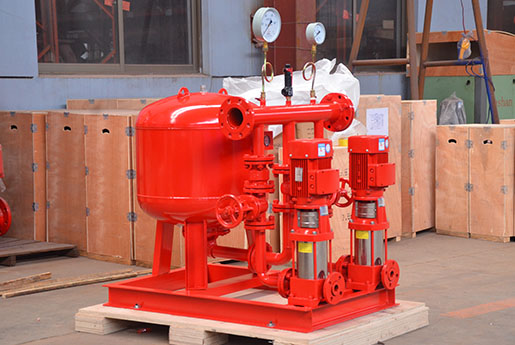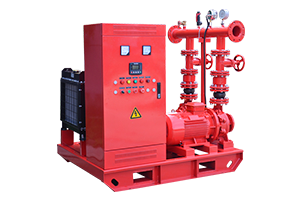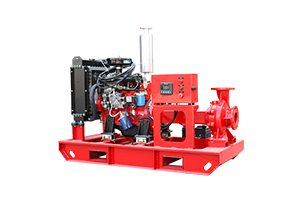-
 Jul 13, 2023What is the effect of fire pump outlet pipe height on self-priming performance?The outlet pipe height of a fire pump can have an impact on the self-priming performance. Self-priming refers to the ability of a pump to evacuate air from the suction line and create a vacuum to draw in water, allowing the pump to operate efficiently. Here's how the outlet pipe height can affect self-priming performance:
Jul 13, 2023What is the effect of fire pump outlet pipe height on self-priming performance?The outlet pipe height of a fire pump can have an impact on the self-priming performance. Self-priming refers to the ability of a pump to evacuate air from the suction line and create a vacuum to draw in water, allowing the pump to operate efficiently. Here's how the outlet pipe height can affect self-priming performance:
Height Limitations: Fire pumps have limitations on the maximum height they can effectively self-prime against. The self-priming capability of a pump is typically specified by the manufacturer and is influenced by factors such as the pump design, impeller type, and motor power. If the outlet pipe height exceeds the pump's self-priming limit, the pump may struggle to prime or fail to prime altogether.
Suction Lift: The outlet pipe height contributes to the total suction lift of the pump. Suction lift is the vertical distance between the water level and the pump's centerline. As the outlet pipe height increases, the suction lift also increases. Higher suction lifts can negatively impact self-priming performance because the pump has to work against a greater head pressure to draw water into the system.
Priming Time: The outlet pipe height can affect the priming time required for the pump to evacuate air and establish water flow. A higher outlet pipe height may result in a longer priming time as the pump needs to overcome a greater head pressure to fill the suction line and prime the pump. This can lead to delays in getting the pump operational.
Pump Design and Features: Some fire pumps are specifically designed to handle higher outlet pipe heights and maintain efficient self-priming performance. These pumps may incorporate features like larger impellers, increased motor power, or specialized priming systems to overcome the challenges posed by higher outlet pipe heights. It's important to consult the manufacturer's specifications and guidelines to determine the suitability of a particular fire pump for a given outlet pipe height.
In summary, the outlet pipe height of a fire pump can impact its self-priming performance. It is crucial to consider the manufacturer's specifications and limitations regarding self-priming capabilities and outlet pipe height to ensure the pump operates effectively and efficiently.
View details -
 Jul 13, 2023Fire Pump Operating InstructionsOperating instructions for a fire pump may vary depending on the specific model and manufacturer. However, I can provide you with some general guidelines for operating a typical fire pump. It's important to note that it is always recommended to refer to the manufacturer's manual and guidelines for the specific fire pump you are using. Here are the general steps involved in operating a fire pump:
Jul 13, 2023Fire Pump Operating InstructionsOperating instructions for a fire pump may vary depending on the specific model and manufacturer. However, I can provide you with some general guidelines for operating a typical fire pump. It's important to note that it is always recommended to refer to the manufacturer's manual and guidelines for the specific fire pump you are using. Here are the general steps involved in operating a fire pump:
Familiarize Yourself: Read and understand the manufacturer's operating manual and guidelines for the specific fire pump you are using. Make sure you are familiar with all the controls, gauges, and safety features of the pump.
Power Supply: Ensure that the power supply to the fire pump is properly connected and functioning. This may involve starting the engine or ensuring that the electrical power source is active.
Priming the Pump: If your fire pump requires priming, follow the manufacturer's instructions to prime the pump. Priming is necessary to remove air from the pump and create a vacuum for water to flow into the system.
Start the Pump: Start the engine or activate the electrical power to begin operating the pump. Follow the manufacturer's instructions for starting the pump, which may involve turning a key, pressing a button, or following a specific sequence.
Monitor Gauges: Pay attention to the pressure gauges on the pump to ensure that the pump is operating within the desired range. There may be separate gauges for suction pressure and discharge pressure. Monitor these gauges throughout the operation.
Control Valves: Familiarize yourself with the control valves on the pump. These valves control the flow of water into and out of the pump. Learn how to open and close these valves as needed to control the water flow.
Discharge Hose: Connect the discharge hose to the pump's outlet and ensure it is properly secured. Position the other end of the hose where it is needed to deliver water to the desired location.
Operate the Pump: Once the pump is running and all the necessary connections are made, you can start operating the pump. Open the necessary control valves and adjust them to achieve the desired flow and pressure. Follow any specific instructions provided by the manufacturer for operating the pump.
Shutdown: When you have finished using the pump, follow the manufacturer's instructions for shutting down the pump properly. This may involve closing valves, turning off the engine, and disconnecting the power supply.
It is important to emphasize that these instructions are general guidelines, and you should always consult the manufacturer's manual and guidelines for the specific fire pump you are using. Additionally, proper training and certification are usually required to operate fire pumps effectively and safely.
View details -
 Jul 12, 2023Common causes of fire pump mechanical seal leakageThere are several common causes of mechanical seal leakage in fire pumps. Some of the primary factors that can contribute to mechanical seal leakage include:
Jul 12, 2023Common causes of fire pump mechanical seal leakageThere are several common causes of mechanical seal leakage in fire pumps. Some of the primary factors that can contribute to mechanical seal leakage include:
Seal Damage or Wear: Mechanical seals can become damaged or worn over time due to factors such as excessive pressure, misalignment, abrasive particles in the pumped fluid, or insufficient lubrication. This can lead to gaps or cracks in the seal, resulting in leakage.
Incorrect Installation: Improper installation of the mechanical seal can compromise its effectiveness and lead to leakage. This can include incorrect alignment of the seal components, insufficient tightening of fasteners, or improper use of sealants or gaskets.
Seal Face Misalignment: If the seal faces are not properly aligned, they may not make adequate contact with each other, resulting in a poor seal. Misalignment can be caused by factors such as shaft deflection, bearing wear, or improper installation.
Excessive Shaft Movement: Excessive axial or radial movement of the pump shaft can cause mechanical seal leakage. This movement can be due to factors such as worn bearings, improper coupling alignment, or excessive vibration in the pump system.
Contaminants in the Pumped Fluid: Abrasive particles, chemicals, or solids present in the pumped fluid can damage the seal faces and compromise their ability to create an effective seal. This can lead to leakage over time.
Insufficient Lubrication or Cooling: Mechanical seals require proper lubrication and cooling to operate effectively. Inadequate lubrication or cooling can cause excessive friction, heat buildup, and accelerated wear of the seal components, resulting in leakage.
Seal Material Incompatibility: Using a mechanical seal made from incompatible materials for the pumped fluid can lead to seal degradation and leakage. It is important to select seal materials that are compatible with the characteristics of the fluid being pumped, including its temperature, pH, and chemical composition.
Operating Conditions: Extreme operating conditions, such as high temperatures, high pressures, or frequent starts and stops, can put additional stress on the mechanical seal and increase the risk of leakage.
Regular inspection, proper maintenance, and adherence to manufacturer guidelines for installation and operation can help minimize mechanical seal leakage in fire pumps. Additionally, using high-quality seals appropriate for the specific application and maintaining proper fluid cleanliness can also contribute to reducing seal leakage.View details -
 Jul 12, 2023Common fire pump mechanical sealCommon mechanical seals used in fire pumps include:
Jul 12, 2023Common fire pump mechanical sealCommon mechanical seals used in fire pumps include:
Single Mechanical Seal: This is the most basic type of mechanical seal used in fire pumps. It consists of two primary sealing surfaces, one stationary and one rotating, that come into contact to create a seal. The stationary part is typically mounted on the pump casing, while the rotating part is connected to the pump shaft. Single mechanical seals are suitable for low to moderate pressure applications.
Double Mechanical Seal: A double mechanical seal consists of two sets of primary sealing surfaces separated by a barrier fluid. This design provides an extra layer of protection against leaks and is commonly used in high-pressure applications or when handling hazardous fluids. The barrier fluid helps to lubricate and cool the seals, enhancing their durability and performance.
Cartridge Mechanical Seal: Cartridge seals are pre-assembled units that contain all the necessary components of a mechanical seal in a single cartridge. They are convenient to install and replace, minimizing the need for complex adjustments and reducing downtime during maintenance. Cartridge seals are often used in fire pumps for their ease of use and reliability.
Balanced Mechanical Seal: In high-pressure applications, a balanced mechanical seal may be utilized. This type of seal incorporates additional design features to counteract the higher forces and pressures present in the pump. By balancing the hydraulic pressure acting on the seal faces, a balanced mechanical seal helps to minimize wear, extend seal life, and improve sealing performance.
It's important to note that specific fire pump manufacturers and applications may have their own preferred mechanical seals or variations of the above designs. Therefore, it is always recommended to refer to the manufacturer's specifications and guidelines for the appropriate mechanical seal to use in a particular fire pump.
View details -
 Jul 11, 2023How to deal with the high-pressure fire pump power failure?Dealing with a power failure in a high-pressure fire pump requires prompt action to ensure the continuity of fire protection. Here are the steps to follow in such a situation:
Jul 11, 2023How to deal with the high-pressure fire pump power failure?Dealing with a power failure in a high-pressure fire pump requires prompt action to ensure the continuity of fire protection. Here are the steps to follow in such a situation:
Notify Authorities: Immediately inform the relevant authorities, such as the fire department or emergency response team, about the power failure in the fire pump. They should be aware of the situation and be ready to provide assistance if needed.
Activate Emergency Power Source: If your facility has an emergency power source, such as a backup generator or an uninterruptible power supply (UPS), activate it as soon as possible. These emergency power sources are designed to provide electricity during power outages and can help maintain the operation of critical systems, including the fire pump.
Verify Power Supply: Check the power supply to the fire pump to ensure that the failure is not isolated to the pump itself. Examine the circuit breakers, fuses, or any other protective devices associated with the pump's electrical connection. If the problem is localized to the fire pump, proceed to the next steps.
Manual Start Option: Some fire pumps have a manual start option that allows you to initiate the pump's operation manually in the event of a power failure. Refer to the pump's operating manual or consult with the manufacturer to determine if this feature is available and how to use it. Follow the instructions to manually start the pump.
Alert Firefighters or Personnel: Notify the firefighting team or designated personnel about the power failure in the fire pump. Inform them of the situation and any alternative measures being taken, such as activating emergency power or initiating manual pump operation. Coordinate with them to ensure appropriate firefighting measures are implemented.
Implement Secondary Water Supply: If the power failure persists or if there is no backup power available, establish an alternative water supply for firefighting purposes. This may involve connecting to an external water source, such as a hydrant, or utilizing onsite water reserves like fire water storage tanks or auxiliary water pumps. Ensure that the secondary water supply is accessible and operational.
Monitor and Assess: Continuously monitor the situation and assess the effectiveness of the alternative measures being implemented. Keep the authorities and relevant personnel informed about the status of the fire pump and any developments. Adjust the firefighting strategies and resources as needed to maintain fire protection capabilities.
Restore Power and Repair: Once the power is restored, or if repairs to the pump or electrical system are required, take the necessary actions to address the root cause of the power failure. Engage qualified personnel or technicians to troubleshoot and rectify the electrical issue. Conduct any necessary repairs or maintenance to ensure the fire pump is fully operational again.
It's crucial to consult with fire protection professionals, local authorities, and adhere to applicable codes and standards when dealing with high-pressure fire pump power failures. They can provide specific guidance based on the unique circumstances and requirements of your facility.
View details -
 Jul 11, 2023Energy consumption analysis of fire pumpAnalyzing the energy consumption of a fire pump involves assessing the power requirements and operational characteristics of the pump. Here are the steps to conduct an energy consumption analysis:
Jul 11, 2023Energy consumption analysis of fire pumpAnalyzing the energy consumption of a fire pump involves assessing the power requirements and operational characteristics of the pump. Here are the steps to conduct an energy consumption analysis:
Determine Power Rating: Identify the power rating of the fire pump, usually specified in horsepower (HP) or kilowatts (kW). This information is typically provided by the manufacturer and can be found in the pump documentation or nameplate.
Assess Duty Cycle: Understand the expected duty cycle of the fire pump. Duty cycle refers to the frequency and duration of pump operation. In some cases, fire pumps may run continuously, while in others, they may operate intermittently or only during specific events.
Calculate Power Consumption: Determine the average power consumption of the fire pump by multiplying its power rating by the duty cycle. For example, if a 100 HP fire pump runs continuously, the power consumption would be 100 HP. If it runs for 1 hour out of every 24 hours, the power consumption would be (100 HP / 24 hours) = 4.17 HP.
Consider Efficiency: Assess the efficiency of the fire pump. Pump efficiency indicates how effectively the pump converts input power into hydraulic power. Efficiency can vary based on the pump type, design, and operating conditions. Check the pump documentation or consult with the manufacturer for the pump's efficiency information.
Calculate Actual Power Consumption: Multiply the power consumption calculated in step 3 by the pump's efficiency to determine the actual power consumed by the pump. For example, if the pump efficiency is 80%, the actual power consumed would be (4.17 HP * 0.8) = 3.34 HP.
Determine Energy Consumption: To calculate the energy consumption of the fire pump, multiply the actual power consumption by the time of operation. For example, if the pump runs for 10 hours, the energy consumption would be (3.34 HP * 10 hours) = 33.4 HP-hours or kilowatt-hours (kWh).
Compare and Analyze: Compare the energy consumption of the fire pump with other electrical equipment or systems to gain a perspective on its energy usage. Assess the efficiency of the fire pump and identify opportunities for energy optimization, such as selecting a more efficient pump or implementing control strategies to minimize unnecessary operation.
Remember that this analysis provides an estimate of the fire pump's energy consumption based on the available information. The actual energy consumption may vary depending on various factors, including pump design, operating conditions, and system requirements.
View details






